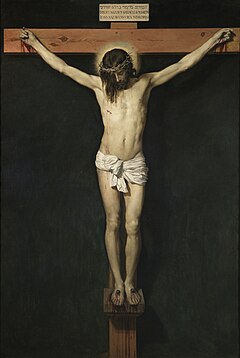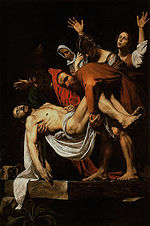
Back صلب يسوع Arabic İsanın çarmıxa çəkilməsi AZ Распяцце Ісуса BE Разпъване на Исус Bulgarian যিশুর ক্রুশারোহণ Bengali/Bangla Crucifixió de Jesús Catalan Ukřižování Ježíše Krista Czech Иисус Христоса пăталани CV Jesu lidelse og død Danish Kreuzigung Jesu German
 | |
| Date | AD 30/33 |
|---|---|
| Location | Jerusalem, Judaea, Roman Empire |
| Type | Execution by crucifixion |
| Cause | Condemnation before Pilate's court |
| Participants | Roman army (executioners) |
| Outcome |
|
| Deaths | Jesus |
| Part of a series on |
| Death and Resurrection of Jesus |
|---|
 |
|
Portals: |
| Events in the |
| Life of Jesus according to the canonical gospels |
|---|
 |
|
Portals: |
| Part of a series on |
| Christianity |
|---|
 |
The crucifixion of Jesus was the death of Jesus by being nailed to a cross.[note 1] It occurred in 1st-century Judaea, most likely in AD 30 or AD 33. It is described in the four canonical gospels, referred to in the New Testament epistles, and later attested to by other ancient sources. Scholars nearly universally accept the historicity of Jesus's crucifixion,[1] although there is no consensus on the details.[2][3][4]
According to the canonical gospels, Jesus was arrested and tried by the Sanhedrin, and then sentenced by Pontius Pilate to be scourged, and finally crucified by the Romans.[5][6][7] The Gospel of John portrays his death as a sacrifice for sin.
Jesus was stripped of his clothing and offered vinegar mixed with myrrh or gall (likely posca)[8] to drink after saying "I am thirsty". At Golgotha, he was then hung between two convicted thieves and, according to the Gospel of Mark, was crucified at the 3rd hour (9 a.m.), and died by the 9th hour of the day (at around 3:00 p.m.). During this time, the soldiers affixed a sign to the top of the cross stating "Jesus of Nazareth, King of the Jews" which, according to the Gospel of John (John 19:20), was written in three languages (Hebrew, Latin, and Greek). They then divided his garments among themselves and cast lots for his seamless robe, according to the Gospel of John. The Gospel of John also states that, after Jesus's death, one soldier (named in extra-Biblical tradition as Longinus) pierced his side with a spear to be certain that he had died, then blood and water gushed from the wound. The Bible describes seven statements that Jesus made while he was on the cross, as well as several supernatural events that occurred.
Collectively referred to as the Passion, Jesus's suffering and redemptive death by crucifixion are the central aspects of Christian theology concerning the doctrines of salvation and atonement.
Cite error: There are <ref group=note> tags on this page, but the references will not show without a {{reflist|group=note}} template (see the help page).
- ^ Eddy, Paul Rhodes and Gregory A. Boyd (2007). The Jesus Legend: A Case for the Historical Reliability of the Synoptic Jesus Tradition. Baker Academic. p. 172. ISBN 978-0801031144.
...if there is any fact of Jesus' life that has been established by a broad consensus, it is the fact of Jesus' crucifixion.
- ^ Christopher M. Tuckett in The Cambridge companion to Jesus edited by Markus N. A. Bockmuehl 2001 Cambridge Univ Press ISBN 978-0-521-79678-1 pp. 123–124
- ^ Funk, Robert W.; Jesus Seminar (1998). The acts of Jesus: the search for the authentic deeds of Jesus. San Francisco: Harper. ISBN 978-0060629786.
- ^ Blomberg (2009), p. 211–214.
- ^ The Cradle, the Cross, and the Crown: An Introduction to the New Testament by Andreas J. Köstenberger, L. Scott Kellum 2009 ISBN 978-0-8054-4365-3 pp. 104–108
- ^ Evans, Craig A. (2001). Jesus and His Contemporaries: Comparative Studies ISBN 0-391-04118-5 p. 316
- ^ Wansbrough, Henry (2004). Jesus and the Oral Gospel Tradition ISBN 0-567-04090-9 p. 185
- ^ Davis, C. Truman (November 4, 2015). "A Physician's View of the Crucifixion of Jesus Christ". The Christian Broadcasting Network. Retrieved September 1, 2020.